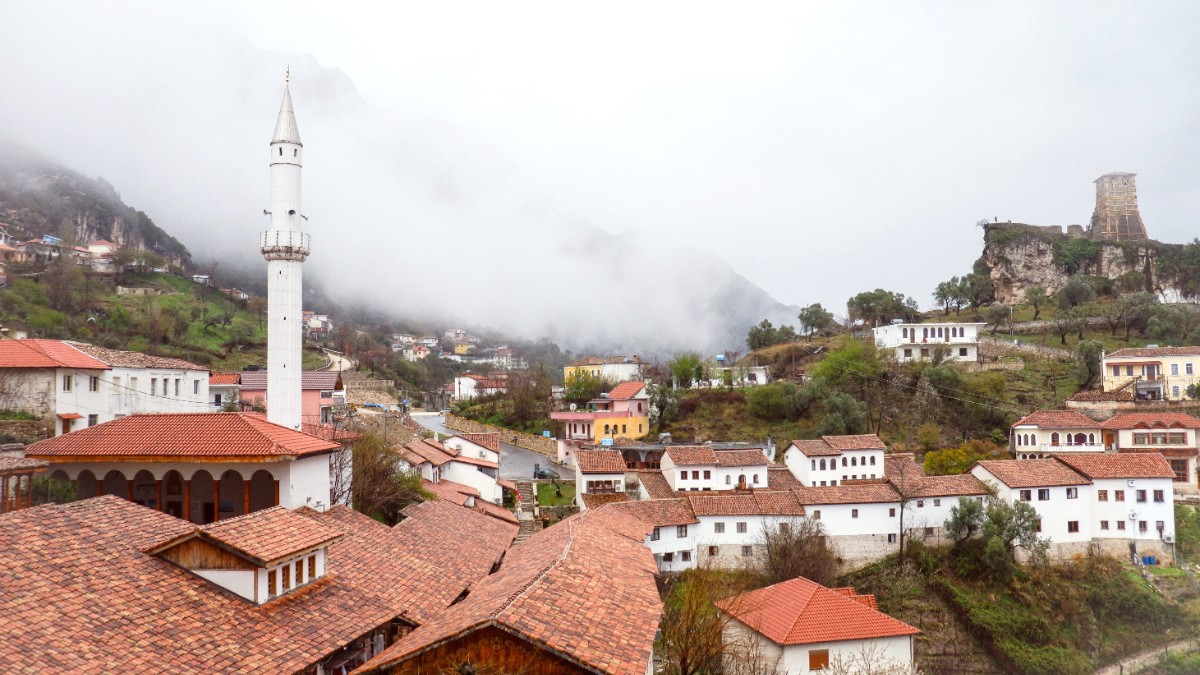
Central Albania, Albania
The city's beauty is immediate, yet its depths unfold slowly, offering rewards to those who explore with curiosity and respect. This guide prepares for a memorable journey into Berat's heart, uncovering its many layers.
Berat nestles in south-central Albania, a pleasant journey of about 120 kilometers (75 miles) south from Tirana, the nation's capital. Its position along the right bank of the Osum River defines its history and unmistakable appearance.
The city's buildings rise organically from the hillside, a seemingly impossible cascade of white stone houses. These structures feature many large windows that seem to gaze outward, earning Berat its well-deserved moniker, "City of a Thousand Windows." This unique vertical arrangement means much of the city is built into sloping terrain, creating a layered effect. The Osum River flows through the valley, acting as a natural divider, separating the ancient Mangalem and Gorica quarters. This placement, nestled between river and mountain, gives Berat a protective natural barrier and a captivating visual charm.
Berat is one of Albania's oldest and most continuously inhabited cities, with a history spanning over 2,400 years. It began as an Illyrian settlement, strategically positioned on a hill. Later, under Roman rule, it became known as Antipatrea. Following the fall of Rome, the city transitioned into the Byzantine Empire, where it received the name Pulcheriopolis, meaning "beautiful city." This period saw the construction of many churches and the flourishing of Christian art.
The most defining period for Berat's architectural character arrived with the Ottoman Empire. For nearly five centuries, Berat served as a prominent administrative and cultural center. During this time, the city developed its unique architectural style, characterized by the white Ottoman houses with numerous windows that cascade down the hillsides of the Mangalem and Gorica quarters. In 2008, UNESCO recognized Berat's outstanding universal value by designating it a World Heritage site. The city is often referred to as a "museum city" due to its remarkably intact historical fabric.
Strategic hillside position, early foundations.
Fortified and integrated into the empire.
Construction of churches, Christian art flourishes.
Unique architectural style, administrative center.
Recognition for preserved history and unique character.
The castle itself is a microcosm of this history. Within its ancient walls, you find remnants of churches from the Byzantine era, alongside mosques built during the Ottoman period. People still live and work inside the castle, making it a living monument rather than a static ruin. This continuous habitation adds an unparalleled dimension to its historical significance, allowing visitors to engage with history not just as observers, but as temporary residents within its narrative.
The iconic Mangalem and Gorica quarters flank the Osum River, each presenting distinct yet complementary views of traditional white houses. Mangalem, often called the "City of a Thousand Windows," captivates visitors with its steep, winding alleys and panoramic views. Gorica, across the elegant stone bridge, offers a quieter atmosphere and equally charming traditional structures.
Berat promotes religious harmony, with mosques and churches standing side by side, reflecting Albania's diverse cultural fabric. This peaceful coexistence is a hallmark of Berat, modeling how different faiths thrive together.
The city also serves as a gateway to natural wonders, including the stunning Osumi Canyon, a popular spot for rafting during spring. This combination of urban heritage and accessible nature makes Berat a versatile travel destination.
A visit to Berat offers a rich blend of exploration. History enthusiasts find satisfaction in the layers of ancient civilizations revealed in the castle and museums. Cultural immersion comes through interaction with locals, stays in traditional guesthouses, and enjoyment of authentic Albanian cuisine. The scenic natural beauty of the Osum River valley and the backdrop of the Tomorr mountain range present opportunities for relaxation and outdoor activities.
Berat offers a slower pace compared to larger cities, allowing visitors to absorb its unique ambiance and appreciate its quiet splendor. The visual impact of its architecture, the echoes of its past, and the warmth of its present combine to form a destination that leaves a lasting impression. It is a place for contemplation, discovery, and genuine connection with a heritage that feels both ancient and alive.
Explore the Osum River valley and the Tomorr mountain range. Opportunities for hiking and scenic views abound.
Wander through Berat Castle and the old quarters, tracing 2,400 years of civilization.
Connect with locals, enjoy traditional guesthouses, and savor authentic Albanian cuisine.
Berat's landscape is defined by its unique geographical positioning.
Hot and dry, good for outdoor activities. Largest crowds, highest prices. Prepare for intense heat.
Pleasant temperatures, fewer crowds, better prices. Ideal for walking and city exploration.
Mild to cool temperatures, higher rain chance. Fewest tourists, lowest prices, authentic experience.
Citizens of the United States, Canada, EU (Schengen), UK, Australia, New Zealand, and many others may enter Albania visa-free for up to 90 days (within 180 days) for tourism. For specific information regarding your nationality, consider checking IVisa or VisaHQ.
Citizens not on the visa-free list require a visa in advance from an Albanian embassy or consulate. Tourist Visa (Type C) for short stays; Long-Stay Visa (Type D) for over 90 days. Application often asks for forms, photos, and supporting documents.
Passport (valid 3-6 months beyond stay), proof of funds, return/onward ticket, accommodation booking. Travel insurance is highly suggested, though not always a strict entry requirement.